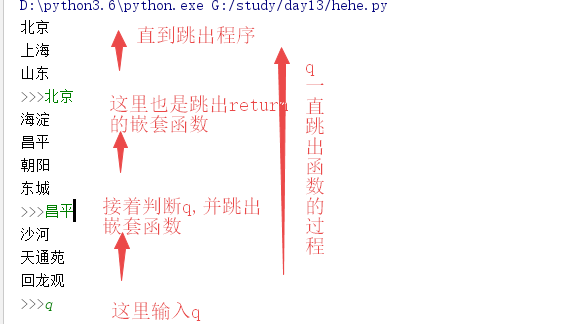一 关于类中的self以及继承问题
请看下面一段代码
class Base: def f1(self): self.f2() def f2(self): print('...') class Foo(Base): def f2(self): print('9999') obj = Foo() obj.f1() #结果为9999
解说:Foo().f1() -->里面的self指的是实例化的对象,而对象继承的是Foo
实例化类Foo,执行对象的f1方法。由于对象没有f1方法,从父类Base中寻找。找到f1方法,def f1(self): 此时self指向的是Foo类的对象。执行self.f2()由于self是Foo类中的,从Foo类中寻找f2方法。找到了,执行输出9999二类的私有属性继承问题

class JustCounter: __secretCount = 0 def count(self): self.__secretCount += 1 print(self.__secretCount) class Bars(JustCounter): def count(self): print(self.__secretCount) counter1 = JustCounter() counter2 = Bars() counter1.count() counter2.count() #类的私有属性不会被继承,这里会报错
三递归函数中变量累加覆盖的问题
使用递归函数的时候,需要一个变量一直累加,但是一旦重新递归函数的时候这个变量也会改变,怎么去做
import os def get_size(path): ret=os.listdir(path) # print(ret) total=0 for name in ret: # print(name) abs_path=os.path.join(path,name) if os.path.isdir(abs_path): total+=get_size(abs_path) #这里递归的同时total也累加了 else: total+=os.path.getsize(abs_path) return total #这里总的大小会稍有变化 print(get_size(r'G:studyday13'))
四计算目录的大小
上面的例子是一个
下面使用堆栈的概念

import os def get_size(path): dir_lst=[path] total=0 while dir_lst: path=dir_lst.pop() ret=os.listdir(path) for name in ret: abs_path=os.path.join(path,name) if os.path.isdir(abs_path): dir_lst.append(abs_path) else: total+=os.path.getsize(abs_path) return total print(get_size(r'G:studyday13'))
找出目录下面的所有文件,并按照从大到小排列
import os my_list=[] def get_size(path): dir_lst=[path] while dir_lst: path=dir_lst.pop() ret=os.listdir(path) for name in ret: abs_path=os.path.join(path,name) if os.path.isdir(abs_path): dir_lst.append(abs_path) else: my_list.append((abs_path,os.path.getsize(abs_path))) return my_list aa=get_size(r'G:studyday22study-moreversion') # print(aa) bb=sorted(aa,key=lambda x:x[1],reverse=True) print(bb)
五 递归中return的真正理解,跳出函数是跳出最近的函数,以三级菜单举例

menu = { '北京': { '海淀': { '五道口': { 'soho': {}, '网易': {}, 'google': {} }, '中关村': { '爱奇艺': {}, '汽车之家': {}, 'youku': {}, }, '上地': { '百度': {}, }, }, '昌平': { '沙河': { '老男孩': {}, '北航': {}, }, '天通苑': {}, '回龙观': {}, }, '朝阳': {}, '东城': {}, }, '上海': { '闵行': { "人民广场": { '炸鸡店': {} } }, '闸北': { '火车战': { '携程': {} } }, '浦东': {}, }, '山东': {}, }

def menu3(menu): while True: for key in menu: print(key) inp=input('>>>').strip() if inp in menu: ret=menu3(menu[inp]) #递归调用menu3函数,将是一个嵌套 if ret=='q':return 'q' elif inp=='b': return 'b' #单纯的返回 elif inp=='q':return 'q' #进入程序单独输入q,直接就是退出menu3函数,这个是没有嵌套的 #进入菜单一直往下走的话,就是使用q在往嵌套函数menu3(menu[inp])的外面跳,直到不嵌套而退出 menu3(menu)

三级菜单堆栈实现

l=[menu] while l: for key in l[-1]: print(key) inp=input('>>>').strip() if inp in l[-1]: l.append(l[-1][inp]) print(l) elif inp=='b':l.pop() elif inp=='q':break
